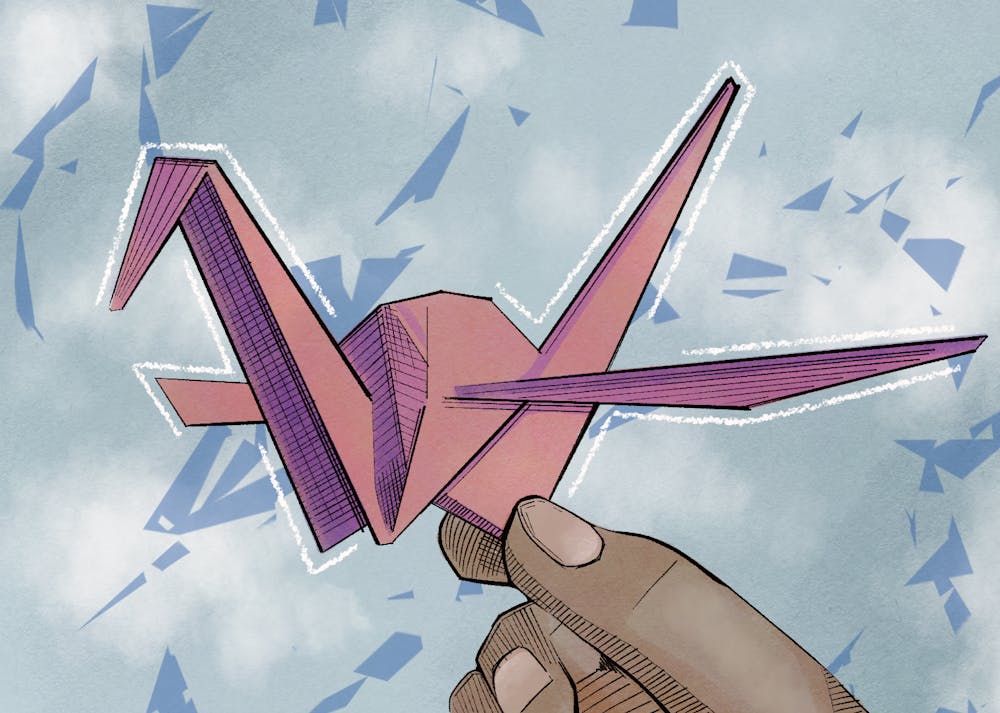In the story of Sadako and the Thousand Paper Cranes, a young girl tried to fold 1,000 paper cranes in the hopes that it would help her push through a terminal illness.
Years later, students across Arizona and at ASU are folding their own cranes to support others through their difficult journeys.
As a high school student, Charles Zhang volunteered at Hospice of the Valley in Gilbert. He founded The Wishing Crane Project in the summer of 2020 after seeing how lonely the COVID-19 pandemic made hospice patients. Motivated by the Japanese story, Zhang said he folded 100 origami cranes with hopeful messages on them and sent them to the hospice center.
Zhang is now a sophomore studying neuroscience and cognitive sciences at the UA. He said he wanted a unique way to support underserved people in his community and remind them that "there's always someone there for them, whether directly or indirectly."
After family members reached out to him saying how much their relatives had enjoyed the art, Zhang was encouraged to start an outreach club at Hamilton High School, where he attended.
The club expanded with chapters at different high schools and colleges, including ASU, established a social media following and, in the summer of 2023, even had a TikTok go viral with 1.8 million views. Now, The Wishing Crane Project has over 1,000 volunteers and chapters all around the world, according to the project's website.
Even though hospitals are not isolated due to COVID-19 protocols anymore, the organization is still able to have significant impacts on patients wherever they are.
"We recognize the fact that (patients) are battling a daily struggle, and that struggle is both mentally and physically painful and challenging," Zhang said. "So even though we just make arts and crafts, patient care packages and other different initiatives, we're able to remind the patients that there is actually someone who genuinely cares for them and that we’re able to provide the support to hopefully bring a small smile to their face."
Tammy Tang, a freshman studying nursing at ASU, volunteered with The Wishing Crane Project during high school.
"I felt like I was helping them make their wish come true," Tang said.
Recently, the organization was able to host a Valentine's Day card-making event as well as a virtual event teaching students how to fold paper cranes.
Activities like this are a unifying way of serving others, according to Zhang. He said that people everywhere can use creative means to reach out to hospices and hospitals, allowing for individual expression but also collective connection through art.
"There's no right or wrong with art, which I think is the best part of it," said Rahi Patel, a senior at Hoggard High School in Wilmington, North Carolina, and the current chief operating officer for The Wishing Crane Project. "I feel like anybody can do it in any shape or form."
Zhang said art bridges the cultural, language and age gap barriers in hospitals and The Wishing Crane Project chapters around the world, "as people from different backgrounds … are able to come together and unite as a whole to create such an impactful difference in other people's lives."
READ MORE: Opinion: We need to make more friends with smile lines
The organization is entirely student-run, giving younger people a chance to connect with and find compassion for those in need, no matter where they come from.
"I think knowing that we have the privilege to help (patients), make their days better, it's good to use what resources and tools and advantages that we have in order to make our world a kinder place," Patel said.
Tang said that, although she was often focused on academics in high school, volunteering with The Wishing Crane Project helped her remember that there are things "other than school that could help for your future," such as "building compassion and patience."
Both Patel and Tang, who are going into medical fields, said volunteering with The Wishing Crane Project helped them find motivation and direction for their future careers.
The Wishing Crane Project helps students grow personally, make a change worldwide and see for themselves how a few small acts of kindness may have big impacts.
"In The Wishing Crane Project, whenever I work on something, whether it's hard or easy tasks, I know that my organization is able to bring dozens, if not hundreds, of smiles on people's faces through arts and crafts," Zhang said. "It’s always been one of my dreams."
Edited by Sophia Braccio, Sadie Buggle and Grace Copperthite.
Reach the reporter at pkfung@asu.edu.
Like The State Press on Facebook and follow @statepress on X.
Pippa Fung is a digital producer, helping to edit and publish articles. This is her fourth semester at The State Press, where she has previously worked for The Echo, politics and senior reporter desks. Pippa has also worked for the Los Alamos National Laboratory's policy office and Boomtown Los Alamos, a local online newspaper.




